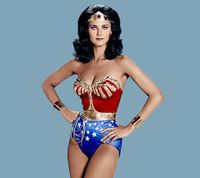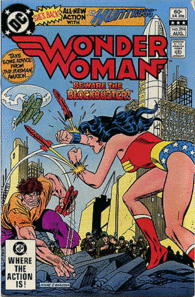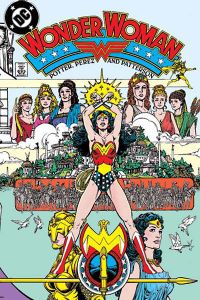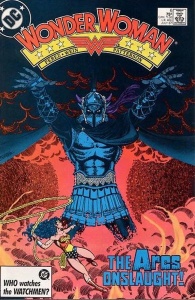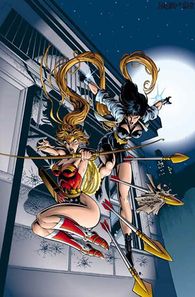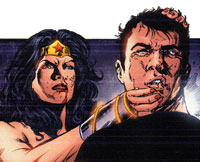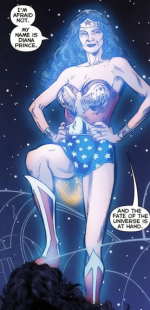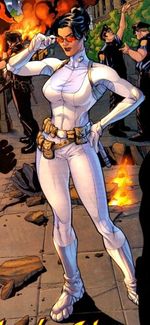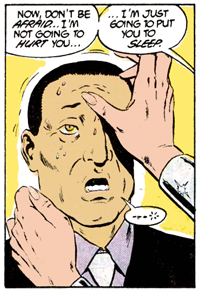Wonder Woman
| Wonder Woman | |
 Cover artwork from Wonder Woman (vol. 3) #5. Art by Terry Dodson | |
| Charachter information | |
| Publisher(s): | DC Comics |
| First Appearance: | Historical: All Star Comics # 8 (Dec. 1941) Modern: Wonder Woman (vol. 2) # 1 (February 1987) |
| Created by: | William Moulton Marston |
| Power(s): |
|
| Real name(s): | Princess Diana of Themyscira |
| Alias(s): | Diana Prince, Goddess of Truth,Miss America |
| Alliances: | Justice League Themyscira |
Wonder Woman is a fictional DC Comics superheroine created by William Moulton Marston. Two strong women, his wife Elizabeth Holloway Marston and Olive Byrne, a mutual lover, served as exemplars for the character and greatly influenced her creation. Wonder Woman first appeared in All Star Comics #8 (Dec. 1941). She is among the first - and most famous - comic book superheroines, and is a founding member of the Justice League.
In addition to comic books, the character was featured in the popular 1975 to 1979 [Wonder Woman (TV series)|television adaptation]] starring Lynda Carter, as well as the Super Friends and Justice League animated series. A 2009 Wonder Woman motion picture adaptation has been announced.
Wonder Woman's origin
Princess Diana is an Amazon from Greek mythology. Her name, "Diana" is reflective of the mythological character, "Diana" or Artemis. Her mother is Queen Hippolyta, or Hippolyta, the queen of the Amazons. When Diana leaves the Amazons to travel to the world outside, she is known as both "Wonder Woman," and as "Diana Prince." As Wonder Woman, she was awarded several gifts by the Olympian gods, including the Lasso of Truth (created from the Golden Girdle of Gaea) and indestructible bracelets/gauntlets (formed from the shield Aegis]). For several years she was described in the splash page of each story, as "beautiful as Aphrodite, wise as Athena, swifter than Mercury, and stronger than Hercules."
History of comic
Origin and creator
In an October 25, 1940, interview conducted by former student Olive Byrne (under the pseudonym 'Olive Richard') and published in Family Circle, titled "Don't Laugh at the Comics", William Moulton Marston described what he saw as the great educational potential of comic books (a follow up article was published two years later in 1942. ) This article caught the attention of comics publisher Max Gaines, who hired Marston as an educational consultant for National Periodicals and All-American Publications, two of the companies that would merge to form the future DC Comics. At that time, Marston decided to develop a new superhero.
In the early 1940s the DC line was dominated by superpowered male characters such as the Green Lantern, Batman, and its flagship character, Superman. According to the Fall 2001 issue of the Boston University alumni magazine, it was his wife Elizabeth Holloway Marston's idea to create a female superhero:
| “ | William Moulton Marston, a psychologist already famous for inventing the polygraph (forerunner to the magic lasso), struck upon an idea for a new kind of superhero, one who would triumph not with fists or firepower, but with love. 'Fine,' said Elizabeth. 'But make her a woman.' | ” |
Marston introduced the idea to Max Gaines, cofounder (along with Jack Liebowitz) of All-American Publications. Given the go-ahead, Marston developed Wonder Woman with Elizabeth (whom Marston believed to be a model of that era's unconventional, liberated woman). In creating Wonder Woman, Marston was also inspired by Olive Byrne, who lived with the couple in a polygamous/polyamorous relationship. Marston's pseudonym, Charles Moulton, combined his own and Gaines' middle names.
Marston was also the creator of a systolic blood-pressure measuring apparatus, which was crucial to the development of the polygraph (lie detector). Marston's experience with polygraphs convinced him that women were more honest and reliable than men, and could work more efficiently.
In a 1943 issue of The American Scholar, Marston wrote:
| “ | Not even girls want to be girls so long as our feminine archetype lacks force, strength, and power. Not wanting to be girls, they don't want to be tender, submissive, peace-loving as good women are. Women's strong qualities have become despised because of their weakness. The obvious remedy is to create a feminine character with all the strength of Superman plus all the allure of a good and beautiful woman. | ” |
Early days
Wonder Woman was introduced in All Star Comics (issue #8; Dec 1941), the second bestselling comic in DC's line. Following this auspicious debut, she was featured in Sensation Comics #1 (January 1942), and six months later appeared in her own book (Summer 1942). Wonder Woman took her place beside the extant superheroines or antiheroes Fantomah Black Widow (from Timely Comics), Invisible Scarlet O'Neil, and Canada's Nelvana of the Northern Lights. Until his death in 1947, Dr. Marston wrote all of the Wonder Woman stories. H. G. Peter penciled the book in a simplistic yet easily identifiable style.
Armed with bulletproof bracelets, Lasso of Truth, and Amazonian training, Wonder Woman was the archetype of Marston's perfect woman. She was beautiful, intelligent, strong, yet still possessed a soft side. Her powers were derived from "Amazon concentration," not as a gift from the gods which would become part of her back story later.
Wonder Woman's "lasso of truth" was forged from the Magic Girdle of Aphrodite, which Queen Hippolyte (Wonder Woman's mother) was granted by the Goddess. Hephaestus had borrowed the Olympian belt, removed several links from it in order to forge the magic lasso which was unbreakable as well as infinitely stretchable, and compelled all encircled by it to obey the commands of the wielder, most notably to tell the truth.
In Wonder Woman's origin story, Steve Trevor, an intelligence officer in the US Army, crashed his plane on Paradise Island, the Amazons' isolated homeland. Using a "Purple Ray," Princess Diana nursed him back to health, and fell in love with him. When the goddess Aphrodite declared that it was time for an Amazon to travel to "Man's World" and fight the evil of the Nazis, a tournament was held to determine who would be the Amazon champion. Although forbidden by her mother, Queen Hippolyte, to participate in the tournament, Princess Diana did so nevertheless, her identity hidden by a mask.
After winning the tournament and revealing her true identity, Queen Hippolyte relented and allowed her daughter to become Wonder Woman. Diana returned Steve Trevor to the outside world, and soon adopted the identity of nurse Lt. Diana Prince (by taking the place of her exact double by that name) in order to be close to Trevor as he recovered from his injuries, after which he became Wonder Woman's crime-fighting partner and romantic interest.
In her guise as a nurse, Diana cares for Trevor and frequently overhears his intelligence discussions, allowing her to know where she is needed. Prince is eventually hired to work for Trevor in the War Department as his assistant. (Trevor periodically suspects that Diana and Wonder Woman might be the same person, especially since he frequently catches Diana using her tiara or lasso.)
Wonder Woman was ably assisted by the Holliday Girls, a sorority from a local women's college led by the sweets-addicted Etta Candy. Etta stood out for several reasons: she had a distinctive figure, occupied a central role in many storylines, and had an endearing propensity for exclaiming "Woo-woo" (which echoed the "Hoo-hoo" catchphrase associated with the popular vaudevillian comedian Hugh Herbert). Etta took her place with Steve Trevor and Diana herself as the series' most enduring characters.
Between 1942 to 1947, images of bound women frequently graced the covers of Sensation Comics and Wonder Woman. For example, in Wonder Woman #3, Wonder Woman herself ties up several other women, and dresses them in deer costumes and chases them through the forest. Later she rebinds them and displays them on a platter. In addition, Diana is rendered powerless if a male manages to chain her bracelets together. The comic's sexual subtext has been noted, leading to debates over whether it provided an outlet for Dr. Marston's sexual fantasies or whether it was meant (perhaps unconsciously) to appeal to, and possibly influence, the developing sexuality of young readers.
The bondage and submission elements had a broader context for Marston, who had worked as a prison psychologist. The themes were intertwined with his theories about the rehabilitation of criminals, and from her inception, Wonder Woman wanted to reform the criminals she captured. (A rehabilitation complex was created by the Amazons on Transformation Island, a small island near Paradise Island (Themyscira).) A core component in Marston's conception of Wonder Woman was "loving submission," in which kindness to others would result in willing submission derived from agape based on Moulton's own personal philosophies. William Moulton Marston:
| “ | Confinement to WW and the Amazons is just a sporting game, an actual enjoyment of being subdued. This, my dear friend, is the one truly great contribution of my Wonder Woman strip to moral education of the young. The only hope for peace is to teach people who are full of pep and unbound force to enjoy being bound. Women are exciting for this one reason - it is the secret of women's allure - women enjoy submission, being bound. This I bring out in the Paradise Island sequences where the girls beg for chains and enjoy wearing them. | ” |
This concept has resulted in parodies of the character in which male criminals are so enamored with the heroine's beauty that they surrender solely to enjoy her company.
During this period Wonder Woman joined the Justice Society of America (featured in All Star Comics) as its first female member. Reflecting the mores of this pre-feminist era, Wonder Woman served as the group's secretary, despite being one of the group's most powerful members.
Upon William Moulton Marston's death in 1947, Robert Kanigher took up the writing duties on Wonder Woman. Diana was written as a less feminist character, and began to resemble other traditional American heroines. Peter produced the art on the title through issue #97, when the elderly artist was fired. (He died soon afterward). During this time, Diana's abilities expanded. Her earrings provided her the air she needed to breathe in outer space, and she piloted an "invisible plane," (originally a propeller-driven Curtiss P-40 Warhawk or P-51 Mustang, later upgraded to a jet aircraft). Her tiara was an unbreakable boomerang, and a two-way wrist radio similar to Dick Tracy's was installed in one of her bracelets, allowing her to communicate with Paradise Island.
Dr. Wertham and the Silver Age
Dr. Fredric Wertham's controversial and influential Seduction of the Innocent (1954) argued that comic books contributed to juvenile delinquency, and alleged that there was a lesbian subtext to the relationship between Wonder Woman and the Holliday girls. Reacting to Wertham's critique and well-publicized Senate hearings on juvenile delinquency, several publishers organized the Comics Code Authority]as a form of pre-emptive self-censorship. Due to a confluence of forces (amongst them the Code and the loss of Marston as writer), Wonder Woman no longer spoke out as a strong feminist, began to moon over Steve Trevor, and, as time wore into the Silver Age, also fell for Merman and Birdman.
Wonder Woman experienced other significant changes from the mid-1950s throughout the 1960s. Harry G. Peter was replaced by Ross Andru and Mike Esposito in 1958 (starting with issue #98), and the character was revamped as were other characters in the Silver Age. In Diana's new origin story (issue #105), it is revealed that her powers are gifts from the gods. Receiving the blessing of each deity in her crib, Diana is destined to become "beautiful as Aphrodite, wise as Athena, strong as Hercules, and swifter than Mercury". Further changes included removing all World War II references from Wonder Woman's origin, changing Hippolyta's hair color to blonde, giving Wonder Woman the ability to glide on air currents, and introducing the rule that Paradise Island would be destroyed if a man ever set foot on it.
Several years later, when DC Comics introduced the concept of the Multiverse, the Silver Age Wonder Woman was situated as an inhabitant of Earth-One, while the Golden Age Wonder Woman was sited on Earth-Two. (It was later revealed, in Wonder Woman #300, that the Earth-Two Wonder Woman had disclosed her secret identity of Diana Prince to the world, and had married her Earth's Steve Trevor])
In the 1960s, regular scripter Robert Kanigher adapted several gimmicks which had been used for Superman. As with Superboy, Wonder Woman's "untold" career as the teenage Wonder Girl was chronicled. Then followed Wonder Tot, the infant Amazon princess (in her star-spangled jumper) who experienced improbable adventures with a genie she rescued from an abandoned treasure chest. In a series of "Impossible Tales," Kanigher teamed all three ages of Wonder Woman; her mother, Hippolyta, joined the adventures as "Wonder Queen".
The Diana Prince era and the Bronze Age
1970s
At the end of the 1960s, under the guidance of editor/plotter/artist Mike Sekowsky, Wonder Woman surrendered her powers to remain in "Man's World" rather than accompany her fellow Amazons to another dimension where they could "restore their magic." (Part of her motivation was to assist Steve Trevor, who was facing criminal charges.)
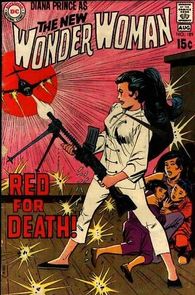
Now a mod boutique owner, the powerless Diana Prince acquired a Chinese mentor named I Ching. Under I Ching's guidance, Diana learned martial arts and weapons skills, and engaged in adventures that encompassed a variety of genres, from espionage to mythology. During this time she fought villains such as Catwoman, Doctor Cyber, the hippie gang THEM!, and the campy witch Morgana.
This new era of the comic book was influenced by the British television series The Avengers, with Wonder Woman in the role of Emma Peel. With Diana Prince running a boutique, fighting crime, and acting in concert with private detective allies Tim Trench and Jonny Double, the character resembled the Golden Age of Comic Books Black Canary. Soon after the launch of the "new" Wonder Woman, the editors severed all connections to her old life, most notably by killing Steve Trevor (Wonder Woman vol. 1 #180).
During the 25 bi-monthly issues of the "new" Wonder Woman, the writing team changed four times. Consequently, the stories display abrupt shifts in setting, theme, and tone. The revised series attracted writers not normally associated with comic books, most notably science fiction author Samuel R. Delany, who wrote two issues (Wonder Woman vol. 1, #202-203).
The I Ching era had an influence on the 1974 Wonder Woman TV movie featuring Cathy Lee Crosby, in which Wonder Woman was portrayed as a non-powered globe-trotting super-spy who wore an amalgam of Wonder Woman and Diana Prince costumes. The era continues to influence stories decades later, most notably Walter Simonson's run (Wonder Woman vol. 2, #189-194). The first two issues of Allan Heinberg's run (Wonder Woman vol. 3, #1-2) include direct references to I Ching, and feature Diana wearing an outfit similar to that which she wore during the I Ching era.
Wonder Woman's powers and traditional costume were restored in 1973 (issue #204). Gloria Steinem was a key player in the restoration. Steinem, offended that the most famous female superheroine had been depowered, placed Wonder Woman (in her original costume) on the cover of the first issue of 'Ms. magazine (1972), which also contained an appreciative essay about the character.
The return of the "original" Wonder Woman was executed by Robert Kanigher, who returned as the title's writer-editor. For the first year he relied upon rewritten and redrawn stories from the Golden Age. Following that, a major two-year story arc (largely written by Martin Pasko) consisted of the heroine's attempt to gain readmission in the Justice League of America. (Diana had quit the organization after renouncing her powers.) To prove her worthiness to rejoin the JLA, Wonder Woman voluntarily underwent twelve trials (analogous to the labors of Hercules), each of which was monitored in secret by a member of the JLA. Towards the end of this story-line, Steve Trevor was resurrected by Aphrodite. He adopted the identity of Steve Howard, and worked alongside Diana Prince (now knowing her true identity) at the United Nations.
Soon after Wonder Woman's readmittance to the JLA, DC Comics ushered in another format change. Following the popularity of the Wonder Woman TV series (initially set during World War II), the comic book was also transposed to this era. The change was made possible by the multiverse concept, which maintained that the 1970s Wonder Woman and the original 1940s version existed in two separate yet parallel, worlds. A few months after the TV series changed its setting to the 1970s, the comic book returned to the contemporary timeline. Soon after, when the series was written by Jack C. Harris, Steve (Howard) Trevor was killed off yet again.
1980s
In 1980, under the pen of Gerry Conway, Steve Trevor was brought back to life a second time. Following Diana's renunciation of her role as Wonder Woman, a version of Steve Trevor from an undisclosed portion of the Multiverse accidentally made the transition to Earth-One. With Diana's memory erased by the Mists of Nepenthe, the new Steve again crash-landed and arrived at Paradise Island. After reclaiming the title of Wonder Woman, Diana returned to Military Intelligence, working with Trevor and re-joined by supporting characters Etta Candy and General Darnell.
In the preview in DC Comics Presents #41 (January 1982), writer Roy Thomas and penciller Gene Colan provided Wonder Woman with a stylized "W," on her bodice, to replace the eagle. The new emblem, unlike the old, could be protected as a trademark and so had greater merchandising potential. After the departure of Thomas in 1982, Dan Mishkin took over writing chores, writing the character with more confidence than had been seen in years, and producing stories that often took surprising and challenging turns.
However, sales of the title continued to decline. Shortly after Mishkin's departure in 1985 (and a 3-issue run by Mindy Newell, along with a well-publicized but never-published revamp by Steve Gerber ), the series ended with issue # 329 (February 1986). Penned by Gerry Conway, the final issue depicted Wonder Woman's marriage to Steve Trevor.
As a result of the alterations which followed the Crisis on Infinite Earths cross-over of 1986, the Wonder Woman and Steve Trevor of Earth-Two, along with all of their exploits, were erased from history. However, the two were admitted into Olympus. At the end of Crisis on Infinite Earths, the Anti-Monitor appeared to have killed the Wonder Woman of Earth-One, but in reality, she had been hurled backwards through time, devolving into the clay from which she had been formed. Crisis on Infinite Earths erased all previously existing Wonder Women from continuity, setting the stage for a complete relaunch and reboot of the title.
Prior to the publication of the second series, a four-part miniseries was released (with Kurt Busiek as writer and Trina Robbins as artist) titled The Legend of Wonder Woman. The series paid homage to the character's Golden Age roots, although it appeared to be set on Earth-One.
Post-Crisis
1987 reboot
Wonder Woman was rebooted in 1987. Writer Greg Potter, who previously created the Jemm, Son of Saturn series for DC, was hired to rework the character. He spent several months behind the scenes working with editor Janice Race on new concepts, before being joined by writer/artist George Pérez. Potter dropped out of writing the series after issue #2, and Pérez became the sole plotter, sometimes writing the finished scripts himself and sometimes being assisted by scripters such as Len Wein and Mindy Newell. Pérez produced 62 issues of the rebooted title.
Pérez and Potter wrote Wonder Woman as a feminist character, and Pérez's research into Greek mythology provided Wonder Woman's world with depth and verisimilitude missing from her previous incarnation. The incorporation of Greek gods and sharply characterized villains added a richness to Wonder Woman's Amazon heritage and set her apart from other DC heroes.
Wonder Woman was now a princess and emissary from Paradise Island (called Themyscira) to Patriarch's world. She possessed stunning beauty and a loving heart, gifts from the goddess Aphrodite. From Athena, she received the gift of great wisdom; from Demeter, the power and strength of the earth; from Hestia, sisterhood with fire; and from Artemis, unity with beasts and the instincts and prowess of a hunter. Finally, from the god Hermes Diana received the gift of speed and the power of flight.
The American theme of Diana's costume was explained by Pérez in the Challenge of the Gods storyline in which Diana engaged in a series of trials arranged by Zeus as punishment for refusing his advances. Diana met the spirit of Steve Trevor's mother, Diana Trevor, who was clad in armor identical to her own. Trevor revealed that during World War II she had crashed on Themyscira while on duty as an US Army pilot. She blundered into an Amazon battle against Cottus, a multi-armed demon, at the portal to the underworld. Trevor was drawn into the battle, although she was armed only with her side arm. She wounded the beast before suffering a mortal blow, allowing the Amazons to reseal the portal.
The Amazons, impressed by this unknown woman's self-sacrifice, entombed her with honors and clothed her in armor displaying the American flag pattern on her uniform (which they assumed were her heraldic colors). Consequently, Princess Diana's costume honors Diana Trevor and, by clothing her in its own heraldry, was intended to ease the heroine's acceptance in Man's world. Trevor's legacy was also the primary reason why Ares arranged for Steve Trevor to bomb the island as he could not resist the irony of the heroine's son unwittingly killing her admirers.
Wonder Woman did not keep her identity a secret, and initially did not consider herself a superheroine. Indeed, her character was wide-eyed and naive, innocent and without guile. Diana spoke only Themyscirian, a variation of ancient Greek, and had to learn English when she arrived in America. Fortunately, Diana soon met Julia Kapatelis, a scholar in Greek culture, and her daughter Vanessa Kapatelis who helped the Amazon princess adjust to the world of Men. However for all her apparent naiveté, Diana was a trained warrior, and had no compunction against using deadly force when called for. (For example, she felled the god Deimos in battle and felt completely justified under the circumstances.) Through Pérez's tenure on the book, Diana confronted war, injustice, inequality, death, and conflicts involving the Olympian Gods.
Wonder Woman's supporting characters were altered as well. In addition to the introduction of the Kapatelises, Steve Trevor was changed into Air Force officer considerably older than Diana, thus sidestepping the traditional romance between the two. Instead, Trevor became involved with Etta Candy, a mature military officer possessing a realistic physique. The Greek war god Ares, and the witch Circe (comics) eventually became two of Diana's greatest enemies. Her rogue's list included the Cheetah, a woman who could transform into a ferocious feline-humanoid creature; and the Silver Swan (comics), a once deformed radiation victim granted beauty, wings, and deafening sonic powers through genetic engineering.
Post-Pérez
Following Pérez, William Messner-Loebs wrote stories that sold well, but the artwork by Mike Deodato often portrayed the Amazon in skimpy outfits and sexualized poses, which drew criticism. Deodato also portrayed the Amazons (with the exception of Phillipus and a few Bana-Mighdallian Amazons) as exclusively Caucasian — including Euboea, who was already established as being of Asian descent. Messner-Loebs' most memorable contribution to the title was the introduction of the red-headed Amazon Artemis of Bana-Mighdall, who took over the mantle of Wonder Woman for a short time. He also included a subplot during his run in an attempt to further humanize Diana by having her work for a fictional fast food chain called Taco Whiz.
John Byrne's run included a period in which Diana's mother Hippolyta served as Wonder Woman, having traveled back to the 1940s, while Diana ascended to Mount Olympus as the Goddess of Truth. Byrne posited that Hippolyta had been the Golden Age Wonder Woman. In addition, Wonder Woman's Amazon ally Nubia was re-introduced (as Nu'Bia; scripted by a different author).
Writer Eric Luke next came aboard the comic and depicted a Diana that was often questioning her mission in Man's World, and most primarily her reason for existing. His most memorable contributions to the title was having Diana separate herself from humanity by residing in a floating palace called the Wonder Dome, and for a godly battle between theTitan Cronus and the various religious pantheons of the world. Phil Jimenez, the penciller who next worked on the title, produced a run which has been likened to Pérez's, particularly since his art bears a resemblance to Pérez's. Jimenez's run showed Wonder Woman as a diplomat, scientist, and activist who worked to help women across the globe become more self-sufficient. Jimenez also added many visual elements found in the Wonder Woman television show.
After Jimenez, Walt Simonson wrote a six-issue homage to the I Ching era, in which Diana temporarily loses her powers and adopts an all-white costume (Wonder Woman vol. 2, #189-194). Greg Rucka became writer at issue #195. His initial story arc centered upon Diana's authorship of a controversial book and included a political subtext. Rucka also introduced a new recurring villain, ruthless businessperson Veronica Cale, who uses media manipulation to try to discredit Diana. Rucka modernized the Greek and Egyptian gods, updating the toga-wearing deities to provide them with briefcases, laptop computers, designer clothing, and modern hairstyles. Rucka dethroned Zeus and Hades (who were unable to move with the times as the other gods had), replacing them with Athena and Ares as new rulers of the gods and the underworld. Athena selected Diana to be her personal champion.
Infinite Crisis
The four part "Sacrifice" storyline (one of the lead-ins to Infinite Crisis) ended with Diana breaking the longstanding do-not-kill code of DC superheroes. Superman, his mind controlled by Maxwell Lord, brutally beats Batman and engages in a vicious fight with Wonder Woman, thinking she is his enemy Doomsday.
In the midst of her battle with Superman, Diana realizes that even if she defeats him, he would still remain under Max Lord's absolute mental control. She creates a diversion lasting long enough for her to race back to Max Lord's location and demand that he tell her how to free Superman from his control. Bound by her lasso of truth, Max replies: "Kill me." Wonder Woman then snaps his neck. (See Wikipedia:The OMAC Project for more about this storyline.)
Upon his recovery, Batman rejects Diana's attempt to explain her actions; Superman is no better able to understand her motivations. At a crucial time, a profound rift opens up between the three central heroes of the DC universe. In the final pages of The OMAC Project, the Brother Eye satellite (the deranged Artificial intelligence controlling the OMACs) broadcasts the footage of Wonder Woman dispatching Maxwell Lord to media outlets all over the world, accompanied by the text MURDER.
At the start of Infinite Crisis, Batman and Superman distrust Diana: the latter can only see her as a coldblooded murderer, the former sees in her an expression of the mentality that led several members of the League to decide to mindwipe their villains. (When he tried to stop the League from mindwiping Doctor Light (Arthur Light) after the villain brutally raped Sue Dibny, Batman's memory was also altered.) To make matters worse, in Infinite Crisis #2 Brother Eye initiates the final protocol "Truth and Justice," which aims at the total elimination of the Amazons. A full-scale invasion of Themyscira is set into motion, utilizing every remaining OMAC. Diana and her countrywomen, now isolated and alienated from the outside world, must fight for their lives.
In Infinite Crisis #3, the Amazons prepare to destroy the OMACs with a powerful new weapon (the Purple Death Ray, a corruption of the healing Purple Ray). Realizing, however, that the battle is being broadcast to TV stations around the world, and edited to make the Amazons look like cold-blooded killers, Wonder Woman convinces the Amazons to shut the weapon down. She then assembles the Amazons on the beach of Themyscira to decide their next move.
Diana calls upon Athena, who transports Paradise Island and the Amazons to another dimension. Wonder Woman chooses not to join them, and is left to face the OMACs on her own. In Infinite Crisis #5, as Diana is breaking up a riot in Boston, Massachusetts, she is interrupted by a woman she initially believes is Queen Hippolyta. However, the intruder identifies herself as the Earth-Two (DC Comics) Wonder Woman, Diana Prince, who has voluntarily left Mount Olympus in order to provide Diana with vital information and guidance. She advises her Post-Crisis counterpart to be "the one thing you haven't been for a very long time... human," and, more importantly, strongly urges Diana to intervene in a fight taking place at that moment between the Modern Age Superman and his counterpart, Kal-L. Having left Mount Olympus, and with her gods' blessings gone, Diana Prince then faded away.
Wonder Woman manages to stop the Supermen from fighting, enabling them to work together in defeating the forces deployed by Alexander Luthor, Jr. and Superboy-Prime (who are revealed as the true culprits behind the Crisis). In the Battle of Metropolis, Diana redeems herself by convincing an anguished Batman not to shoot Alexander Luthor, Jr. to death. At the story's conclusion, Diana, Bruce Wayne, and Clark Kent interact like the friends they were in the past, and Diana declares her intention to do some soul-searching before returning to her role as Wonder Woman.
Near the conclusion of the Crisis the history of Earth is modified. Wonder Woman's Silver Age past is restored, and it is revealed that she has also served as a founding member of the Justice League.
DC announced that Wonder Woman (vol.2) would be one of several titles cancelled at the conclusion of Infinite Crisis; issue #226, released in February 2006, was the final issue.
Wonder Woman vol. 3
In conjunction with DC Comics's "One Year Later" event, the third Wonder Woman comic series was launched with a new #1 issue (June 2006), written by Allan Heinberg with art by Terry Dodson.
Donna Troy has taken up the mantle of Wonder Woman; Diana has disappeared to parts unknown, though there are reports that she has been seen in the company of an eastern mystic named I Ching. The World Court drops the charges against Diana for the killing of Maxwell Lord.
When Diana returns she takes on the persona of Diana Prince (previously used during both George Pérez and John Byrne's run), now a secret agent and member of the Department of Metahuman Affairs. She is partnered with Nemesis; the two report to Sarge Steel. Her first assignment is to retrieve her sister Donna Troy, who has been kidnapped by several of her most persistent enemies; their powers have been augmented by Circe. After this is accomplished, Diana takes back the title of Wonder Woman.
Wonder Woman, Superman, and Batman re-form the Justice League of America and collaborate on the team's roster.
Wonder Woman asks Kate Spencer (whom she knows to be Manhunter (Kate Spencer) to represent her before a Federal grand jury empaneled to determine if she should be tried for the murder of Maxwell Lord. (Though the World Court has exonerated her, the US government pursues its own charges.) Upon concluding their deliberations, the grand jurors refuse to indict Diana.
During the story-arc penned by Jodi Picoult (issues #6-10, and which ties into Amazons Attack!), Diana is captured and imprisoned by the Department of Metahuman affairs, led by an imposter Sarge Steel. She is tortured and interrogated to garner information that will allow the United States government to build a Purple Death Ray previously used during Infinite Crisis.
For reasons of her own, Circe resurrects Diana's mother Hippolyta. When Hippolyta learns that her daughter is being detained by the US government, she goes on the warpath, leading an Amazon assault on Washington, D.C. Freed by Nemesis, Diana tries to reason with her mother to end the war.
Gail Simone will serve as the title's writer beginning with issue #14.
Powers and abilities
The original Wonder Woman, like all Amazons, was able to will tremendous amount of brain energy into her muscles and limbs by Amazon training which endowed her with extraordinary strength and agility. The Wonder Woman show (Fausta: The Nazi Wonder Woman 1976) confirmed this notion; "... we are able to develop our minds and physical skills ...", and in the first episode of Super Friends]1973: "... the only thing that can surpass super strength is the power of the brain", she says flying Aquaman to the trouble-alert. What was repeated in early Wonder Woman stories since 1941 is basically that Amazon training involved this ability using pure mental energy, and that "anyone could do it ... with will power and Amazon training."
However, contradictions to her origin with the inclusion of Wonder Girl and Wonder Tot made chroniclers invent new explanations of her powers and origin. This unfortunate distortion gave rise to Diana being a super-Amazon; capable of feats which her sister Amazons would find no equal. This would be clearly defined in Wonder Woman Volume One #105, which reveals that Diana received her awesome powers by the gods and goddesses while in her cradle (Beautiful as Aphrodite, Wise as Athena, Stronger than Hercules and Swifter than Mercury). However over the years there were exceptions, between the years 1966 and 1967, Wonder Woman's mythos were returned to the original interpretation.
It is difficult to define the true extent of her powers as new abilities were continually added; the ability of super breath (to blow incredible jet streams or make water to snow); ventriloquism; withstand extreme heat and cold; ride the air currents as if flying; mental telepathy (even to project images); microscopic vision; the ability to vibrate into another dimension, and other abilities which are noted in the "Encyclopedia of Comic book Heroes Volume Two 1976". Depending on the chronicler, her powers and abilities would either be vastly godlike, or just above the strength of an average man. To avoid any other confusion, the events of the 1985 Crisis on Infinite Earths erased Wonder Woman's convoluted history and Wonder Woman was rebooted in 1987 with a new record of her powers and abilities.
In the revised history, Diana possesses a host of superhuman powers granted to her by the gods and goddesses of Olympus, gifts which have been stated to be equal to their own abilities. Primary among these are superhuman strength and stamina, which she draws from a mystical link to the Earth itself granted by Demeter.
Diana is one of the strongest superheroes in the DC Universe. Her stamina affords her an incredible degree of resistance to blunt force trauma. However, Diana's skin is not totally invulnerable and can be pierced by sharp projectiles with sufficient force distributed over a small surface area such as bullets or arrows.
Born of the clay of Themyscira, and given life and divine powers by the gods themselves, Diana has heightened resistance to magical attacks. She is experienced in battling foes who use sorcery as a weapon. As a divine creation herself, she is less susceptible to manipulation by magic than many of her fellow heroes. Like the Earth, Diana is constantly renewing herself, allowing her to quickly heal. In cases where she is gravely injured or poisoned, Diana has shown the ability to physically merge with the earth, causing whatever injuries or poisons she has incurred to be expelled from her body as it regains shape. This ability is shared by all the Themyscirian Amazons and is considered a sacred act, and is seldom used.
Diana is the finest warrior ever born to the Amazons of Themyscira. She is a master of armed and unarmed combat, proficient with nearly every weapon ever made, especially the bow and the javelin, and the exotic martial arts styles practiced by the Amazons. Because those martial skills are not practiced outside of Themyscira, Diana is extremely difficult to defeat in open battle. She has at times engaged in battle with beings of greater strength or (such as Superman, Darkseid, or Olympian Gods) and prevailed.
The Goddess Artemis has granted Diana the "The Eye Of The Hunter" which gives Diana enhanced senses, as well as "Unity With Beasts" allowing Diana to communicate with all forms of animals (including dinosaurs) and her presence alone can bring a raging beast to a calm standstill.
Shortly before Infinite Crisis, Wonder Woman blinded herself in order to save millions of lives during her fight with the Gorgon Medousa; her sight was later restored by Athena as a gift - binding her own eyesight to her champion, Diana. Since then, she has possessed the sight of Athena, or the gift of increased insight. Consequently, Diana can detect others' emotions, is now fully immune to Doctor Psycho's illusions and also mind control as shown during the conclusion of the Sacrifice storyline when Maxwell Lord tried to telepathically control her but was unable to do so.
Diana possesses great wisdom and intelligence, primary gifts from the Goddess of Wisdom herself, Athena. Diana has exhibited heightened proficiency with languages, being able to speak her native Themysciran, Ancient and Modern Greek, English, Portuguese, Spanish, French, Mandarin Chinese (she expressed "difficulty" with the tones of Cantonese during an interview with Lois Lane), Russian, and Hindi.
This same gift of Wisdom makes Wonder Woman an accomplished strategist and tactician, practiced in the arts of leadership, persuasion and diplomacy. For a short time during the George Pérez and William Messner-Loebs run on the comic, Diana was shown to possess the ability to astrally project herself into various lands of myth in order to interact with or seek advice from creatures there. In some cases, she has shown the ability to place individuals into a state of sleep while under the power of her golden lasso.!-- <ref>Wonder Woman Vol. 2 #20 suggests that this power is in direct correlation to Morpheus, the God of Dreams.--> However, this ability might be a common technique prevalent in Amazonian society, since Queen Hippolyta used this technique on Diana herself during the Our Worlds at War event.
After the 1987 George Perez reboot, Wonder Woman was given the ability to fly at supersonic speeds under her own power rather than having to use an invisible jet as she had done in previous decades. This was apparently done for simplicity's sake. This carried over into the Justice League animated series, where Wonder Woman also has the power to fly on her own.
Weapons
Diana has numerous powerful weapons at her disposal, but her signature weapons are her indestructible bracelets and the Lasso of Truth. The Bracers of the Aegis (in Pre Crisis: Silver Bracelets of Victory) were formed from the remnants of Zeus's legendary Aegis shield, and were created for her by Hephaestus. Diana's superhuman reflexes and senses allow her to deflect projectiles and bullets, including automatic weapons fire, as well as energy blasts and lasers from beings such as Ares and Darkseid She is fast enough to protect herself from multi-vector attacks. At close-range the indestructible gauntlets block blades, weaponry, and punches. Diana has used the gauntlets as a dual defensive/offensive weapon, redirecting energy blasts back to their point of origin or at other targets. When crossed, the gauntlets generate a larger remnant of the Aegis itself, forming an impenetrable barrier which allows Diana to protect herself and those behind her from area attacks.
The Lasso of Truth (also known as the Lariat Of Hestia), forged from her aunt Antiope's Golden Girdle of Gaea, is perhaps Diana's greatest and most versatile weapon. The divine Lasso is absolutely unbreakable and has restrained beings as powerful as Superman, Captain Marvel, and the gods Ares and Hades. The Lasso burns with a magical aura called the Fires of Hestia, forcing anyone within the Lasso's confines to speak the absolute truth. The Fires can restore lost memories, dispel illusions, renew the wielder's body, protect those encircled by it from magical and nonmagical attacks, and even cure insanity. Additionally, Wonder Woman has used the fire to create impenetrable barriers. Although some writers established that no one but Diana can wield the Lasso due to its divine nature, Donna Troy used it during her tenure as Wonder Girl and Wonder Woman. (Donna was created from a portion of Diana's own soul). In recent years, artists and inkers have depicted the Lasso as a fiery weapon, coursing with power. (This is due, in part, to advances in the coloring processes now used in comics.) During Grant Morrison's run on JLA, artist Howard Porter frequently drew Diana wielding the flaming Lasso, with absolute control, in elaborate and serpentine configurations.
Wonder Woman's golden tiara has also doubled as a throwing weapon, used for long-distance attack or defense. Hurled with Diana's superhuman strength, the razor-edged crown can cut through most substances before returning to her. She decapitated the god Deimos with it during their first meeting, and during the "Sacrifice" storyline she used the tiara to injure Superman's throat and impede his attack on her.
Diana used the Sandals of Hermes to cross the dimensional impasse between Themyscira and the outside world, but they were passed on first to Artemis, and later to Wonder Girl. Diana also once wielded the Gauntlet of Atlas, which magnifies the physical strength and stamina of the wearer by a factor of ten. Diana used the Gauntlet several times, most notably to destroy a clone of the Superman-killer Doomsday, but it raised her already superhuman strength to a level that she found difficult to control.
Wonder Woman has at her disposal a small lightweight disc of alien (Lansinar) technology that, when triggered by her thoughts, transforms into a transparent version of whatever object or vehicle is appropriate for her needs. The device has been used for several purposes, including a communication device, but is most frequently used by Diana in the form of an invisible jet plane, thus reintroducing this vehicle for the first time in post-Crisis continuity. She has also used the amorphous disc in partnership with Green Lantern's power ring to hold Earth's moon together while shifting its orbit.
A classic warrior, Diana occasionally uses additional weaponry in formal battle. She uses ceremonial golden armor complete with golden wings, war-skirt and chest-plate, and a golden helmet in the shape of an Eagle's head. In warfare, she may wield a bow & arrow, a spear, or a labrys (a doubled-bladed axe). Owing to the honored self-sacrifice of Diana Trevor, Wonder Woman uses many American themes such as an American Flag sort of cape/sword holster. Moreover, she uses a golden shield with American symbols and themes. Her deadliest piece of battle-gear is a magically forged sword (again a gift from Hephaestus), so sharp that it can carve the electrons off an atom. In the Elseworlds story Kingdom Come, Superman was cut by this sword while running his fingers down the blade.
Further reading
- Les Daniels, Wonder Woman: The Complete History, (Chronicle Books, 2000).
- Michael L. Fleisher (with the assistance of Janet E. Lincoln), The Original Encyclopedia of Comic Book Heroes Volume 2: Wonder Woman, (DC Comics, 2007; orig. pub. 1976).
- Joshua Glen, "Wonder-working Power," Boston Globe, 04 April 2004.
- Marguerite Lamb, "Who Was Wonder Woman? Long-ago LAW alumna Elizabeth Marston was the muse who gave us a superheroine," Boston University, Fall 2001.
- Richard, Olive. Our Women Are Our Future. Family Circle, 14 August 1942.
Notes
See also [ Professor Marston and the Wonder Women ]
External links
Chat rooms • What links here • Copyright info • Contact information • Category:Root
